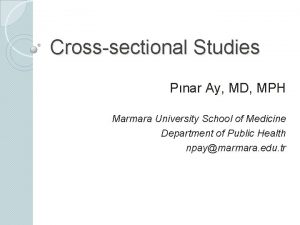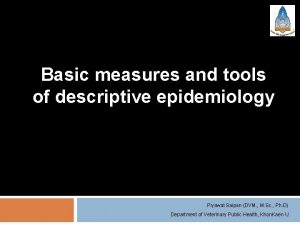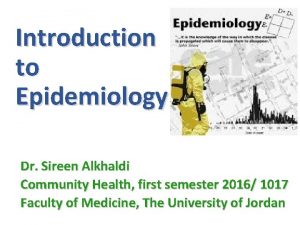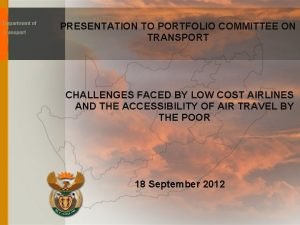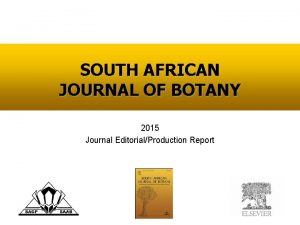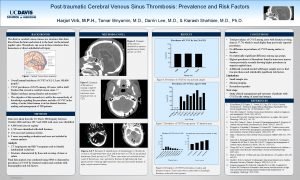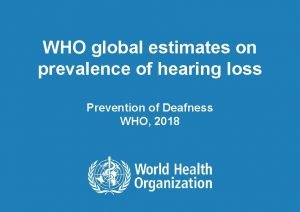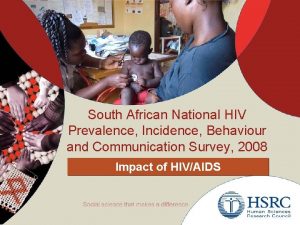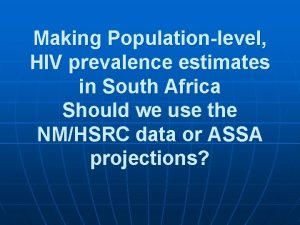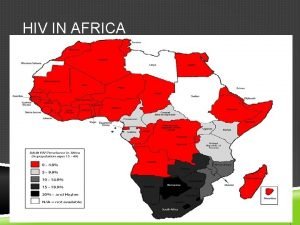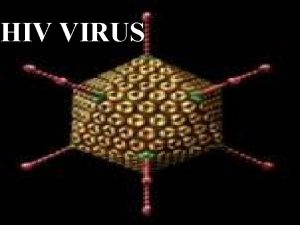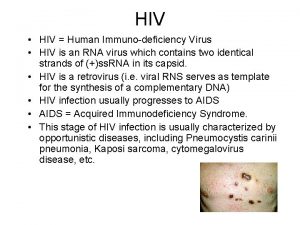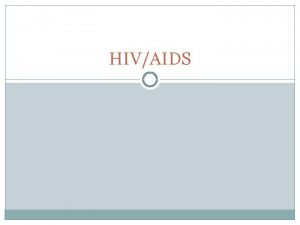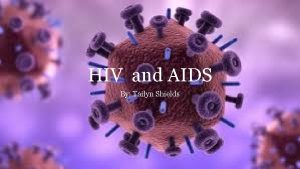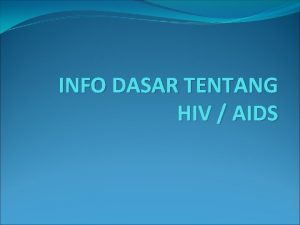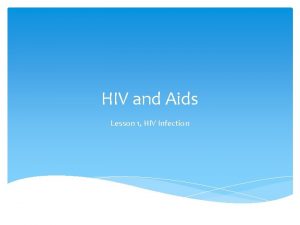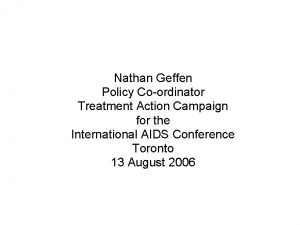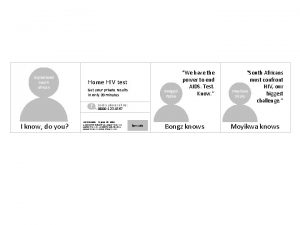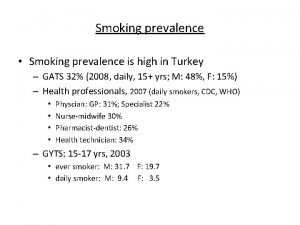District Prevalence of Unsuppressed HIV in South African





























- Slides: 29

District Prevalence of Unsuppressed HIV in South African Women: Monitoring Programme Performance and Progress Towards 90 -90 -90 Boston University Slideshow Title Goes Here Jacob Bor 1, 2, Alana Brennan 1, 2, Matthew Fox 1, 2, Mhairi Maskew 2, Wendy Stevens 3, Sergio Carmona 3, Bill Mac. Leod 1, 2 1 Department of Global Health, Boston University School of Public Health, USA, 2 Health Economics and Epidemiology Research Office, University of Witwatersrand, South Africa, 3 National Health Laboratory Service, South Africa and Department of Molecular Medicine and Haematology, University of the Witwatersrand Funded by NIAID R 01 AI 115979, NIMH

Monitoring progress to 90 -90 -90 Boston University Slideshow Title Goes Here § How do we measure success? § How do we identify areas of unmet need?

Monitoring progress to 90 -90 -90 Boston University Slideshow Title Goes Here § How do we measure success? § How do we identify areas of unmet need? § Traditional approach: the conditional cascade of care

Conditional Cascade of Care Boston University Slideshow Title Goes Here HIVinfected 90% tested Diagnosed and linked to care Initiated ART 90% ART | tested Virally suppressed 90% VL<1000 | tested, ART

Monitoring progress to 90 -90 -90 Boston University Slideshow Title Goes Here § § How do we measure success? How do we identify areas of unmet need? Traditional approach: the conditional cascade of care Problem 1: selection bias implies moving targets § Patients not yet tested likely have lower demand for lifelong ART § As countries scale up “treat all”, testing and linkage will increase, but ART initiation and viral suppression – conditional on testing – may fall § Comparisons over time and space may be misleading § The potential for selection bias is quite real…

Lower ART uptake at higher CD 4 counts 0. 80 Boston University Slideshow Title Goes Here Proportion starting ART in 6 months 0. 70 0. 67 0. 64 0. 60 0. 62 0. 59 0. 53 0. 50 0. 51 0. 48 0. 40 <=50 51 -100 101 -150 151 -200 201 -250 251 -300 301 -350 CD 4 count at diagnosis Source: Chiu et al. (poster at AIDS 2016), Africa Centre for Population Health

Monitoring progress to 90 -90 -90 Boston University Slideshow Title Goes Here § § § How do we measure success? How do we identify areas of unmet need? Traditional approach: the conditional cascade of care Problem 1: selection bias implies moving targets Problem 2: cascade does not capture prevention § The denominator of the cascade is the HIV-infected population § But we have techniques to reduce % of population that is HIV-infected: Condoms, Pre. P, MMC, Secondary Schooling, Tas. P

Monitoring progress to 90 -90 -90 Boston University Slideshow Title Goes Here § § § How do we measure success? How do we identify areas of unmet need? Traditional approach: the conditional cascade of care Problem 1: selection bias implies moving targets Problem 2: cascade does not capture prevention Problem 3: facility- not population-based perspective § Cascade designed based on what can be monitored at facility level. § But our ultimate goals – reduction of incidence, morbidity, and mortality – are population-based goals.

Monitoring progress to 90 -90 -90 Boston University Slideshow Title Goes Here § § § § How do we measure success? How do we identify areas of unmet need? Traditional approach: the conditional cascade of care Problem 1: selection bias implies moving targets Problem 2: cascade does not capture prevention Problem 3: facility- not population-based perspective A public health measurement challenge § How can we best measure programme performance and unmet need when population health impact has a significant lag?

Inverting the Cascade of Care Boston University Slideshow Title Goes Here Total Population HIVinfected Incidence HIV+, unsuppressed • High risk for HIV transmission • Morbidity, mortality if treatment is substantially delayed Diagnosed and linked to care Initiated ART HIV+, suppressed • Life expectancy ~HIV-negatives • HIV transmission close to zero Virally suppressed

Population-based key indicators Boston University Slideshow Title Goes Here 1. Population prevalence of unsuppressed HIV § § # HIV-infected and VL>1000 / # total population Unmet need for HIV treatment and prevention services Key causal determinant of HIV morbidity and mortality Key causal determinant of HIV incidence (direct/indirect) 2. Percent suppressed in HIV-infected population § # HIV-infected and VL<1000 / # HIV-infected § Programme performance for the treatment programme § “Effective coverage”

Objective Boston University Slideshow Title Goes Here 1. Measure programme performance and unmet need for HIV services at a population level using routine programme and surveillance data 2. Describe geographic variability in programme performance and unmet need in South Africa

Data sources Boston University Slideshow Title Goes Here § District level, n=52 § N, Number of women ages 15 -49 § South African Census, 2011 § p, HIV prevalence in pregnant women § Antenatal Surveillance HIV Prevalence estimates, pooled 2011/2012 § r, Ratio of prevalence in pregnant vs. all women, 15 -49 § HSRC National Survey 2012 (national estimate) § A, Number of patients receiving ART § District Health Information System 2012 § v, Proportion of patients virally suppressed § National Health Laboratory Services, 2012 § De-duplicated through novel record linkage, NHLS National HIV Cohort

Methods § # HIV-infected = N*p/r Boston University Slideshow Title Goes Here § # HIV-infected, suppressed = A*v § Unsuppressed HIV prevalence = (N*p/r – A*v) / N § Percent suppressed in HIV-infected = (A*v) / (N*p/r) § Assumptions § Ratio r is constant across districts, apart from demographics § No patients are virally suppressed without treatment § Patients who are not virally monitored have same probability of viral suppression as patients who are virally monitored.

Population viral suppression Boston University Slideshow Title Goes Here Substantial heterogeneity in population viral suppression

Population viral suppression Boston University Slideshow Title Goes Here

Population viral suppression Boston University Slideshow Title Goes Here Viral suppression highest in highprevalence districts.

Population viral suppression Boston University Slideshow Title Goes Here Viral suppression highest in highprevalence districts. Many districts far from 90 -90 -90 target.

Unsuppressed HIV prevalence Boston University Slideshow Title Goes Here

Unsuppressed HIV prevalence Boston University Slideshow Title Goes Here ART scale-up has led to a reduction in the proportion of the population at risk for transmitting HIV.

Unsuppressed HIV prevalence vs. total HIV prevalence Boston University Slideshow Title Goes Here

Unsuppressed HIV prevalence vs. total HIV prevalence Boston University Slideshow Title Goes Here Success of ART programme

Unsuppressed HIV prevalence vs. total HIV prevalence Boston University Slideshow Title Goes Here Unmet need for HIV services

Unsuppressed HIV prevalence vs. total HIV prevalence Boston University Slideshow Title Goes Here • Hardest to reach • Highest transmission risk • Performance on ART unknown Unmet need for HIV services

Ranking Boston University Slideshow Title Goes Here Districts with the highest HIV prevalence are not the districts with the highest unsuppressed HIV prevalence.

Ranking Boston University Slideshow Title Goes Here Districts with the highest HIV prevalence are not the districts with the highest unsuppressed HIV prevalence.

Ranking Boston University Slideshow Title Goes Here Districts with the highest HIV prevalence are not the districts with the highest unsuppressed HIV prevalence.

Conclusions Boston University Slideshow Title Goes Here § Population viral suppression and unsuppressed HIV prevalence are easily-interpretable measures of program performance and unmet need at the population level. § Can be estimated in routine program and surveillance data, including NHLS National Patient Cohort. § Large variability in population viral suppression presents opportunity to learn from high-performing districts. § Districts with greatest unmet need were not those with highest HIV prevalence, suggesting successful targeting but also a need for renewed focus on districts with high prevalence of unsuppressed HIV.

Thank you and Acknowledgments Boston University Slideshow Title Goes Here § § § Patients, care providers, and NHLS staff Sue Candy and colleagues at the NHLS CDW Research colleagues at BUSPH and HE 2 RO National Department of Health Funders § NIH (NIAID, NIMH) § PEPFAR § USAID
 Period prevalence formula
Period prevalence formula Period prevalence vs point prevalence
Period prevalence vs point prevalence Period prevalence vs point prevalence
Period prevalence vs point prevalence Period prevalence vs point prevalence
Period prevalence vs point prevalence South african tax
South african tax Hamilton naki
Hamilton naki South african council for natural scientific professions
South african council for natural scientific professions National archives and records service of south africa
National archives and records service of south africa Sacap architectural compliance certificate
Sacap architectural compliance certificate Saaqis
Saaqis South african principals association
South african principals association The south african apartheid
The south african apartheid South african freedom charter pdf
South african freedom charter pdf Louay safi
Louay safi South african transport conference
South african transport conference Hartswater bosluis
Hartswater bosluis 1994 apartheid
1994 apartheid South african tax
South african tax South african journal of botany impact factor
South african journal of botany impact factor Southern african transport conference
Southern african transport conference Anglophone south school district
Anglophone south school district South central district wels
South central district wels South kitsap school district skyward
South kitsap school district skyward Central kitsap school district human resources
Central kitsap school district human resources Old south vs new south streetcar named desire
Old south vs new south streetcar named desire Calculate prevalence rate
Calculate prevalence rate Prevalence vs incidence
Prevalence vs incidence Cvst prevalence
Cvst prevalence Who global estimates on prevalence of hearing loss 2020
Who global estimates on prevalence of hearing loss 2020 Prevalence of schizophrenia
Prevalence of schizophrenia

